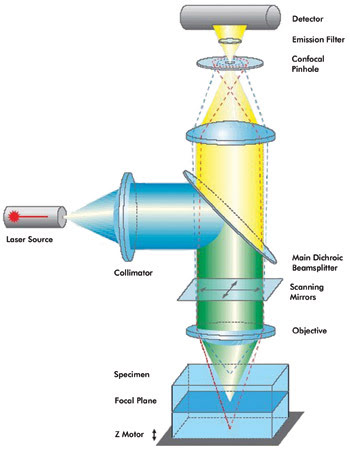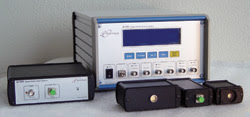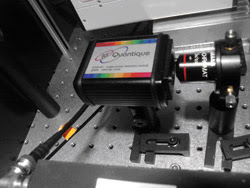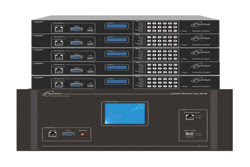Photon counting is showing up in an array of uses, including medical, environmental, aerospace, defence and quantum optics.
“Single-photon detectors find application in various fields, such as time-correlated photon counting, fluorescence measurement, single-molecule detection, environment analyses, laser rangefinders, quantum cryptography and others,” said Dr. Danielle Moraes, sales manager of instrumentation at id Quantique SA of Geneva.

Fluorescence spectroscopy needs a very sensitive detector for the small number of photons emerging from the focal plane within the specimen. Courtesy of Carl Zeiss MicroImaging.
Single-molecule fluorescence spectroscopy is a technique for studying structures, functions and dynamics in biological systems. It requires a very sensitive detector with good timing resolution. The specimen emits only a small number of photons because of its tiny volume and the low light level required to avoid cell damage.

A selection of instrumentation products from the portfolio of id Quantique: the id400 (front left), the id201 (back right), the id300 (back left) and the id100 series. Courtesy of id Quantique.
To improve both counting rate and timing resolution, id Quantique has integrated active quenching electronics on the photodiode sensor chip. The id100 single-photon counter detects very weak signals at wavelengths from 350 to 900 nm, with a time resolution of 40 ps, a dead time of 45 ns and a dark count rate below 1 Hz. It is a silicon avalanche photodiode manufactured using CMOS technology.

The id100 single-photon counter is a silicon avalanche photodiode that detects very weak signals in this fluorescence measurement application. Courtesy of id Quantique.
From light to electricity
Photodiodes convert light into an electric current. Avalanche photodiodes amplify that current by using a strong electric field, giving each electron enough energy to produce a whole avalanche of secondary electrons. This makes the detector much more sensitive but necessitates a quenching mechanism so that the avalanche does not damage the sensor or go on forever. Reducing the accelerating voltage for a short period stops the avalanche but creates a “dead time” during which the sensor is unresponsive. The short dead time of the id100 enables it to work with pulsed light at up to 20 MHz.
The id100 family includes free-space modules with 20- or 50-μ:m photosensitive areas and a fibre-coupled module with standard FC/PC input. They are available in standard and ultralow-noise grades. There also is the id101 miniature series for OEM use and the id150 miniature eight-channel photon counter for large-volume OEM applications such as biological, chemical and astronomical instrumentation, environmental analysis and optical time-domain reflectometry.
Quantum cryptography
Quantum cryptography depends upon quantum mechanics and information theory. It turns the paradoxes and restrictions of quantum physics to practical use; for example, because measurement perturbs a system, eavesdropping is obvious, so this quantum mechanics restriction helps security. The “bits” of information in quantum cryptography take the form of individual photons, with different polarization states to represent binary 1 and 0. Therefore, single-photon detectors are necessary to quantum cryptography.

The Cerberis network security solution combines the QKDS (quantum key distribution server) at the bottom with up to 12 high-speed layer 2 encryption boxes stacked on top. Courtesy of id Quantique.
The Geneva government used id Quantique’s Cerberis encryption system in the Swiss federal elections and has decided to use quantum cryptography in all future elections in the canton. Cerberis is a scalable encryption system allowing companies and organizations to protect the data transmitted within their internal computer networks and through external links.
Messages are encrypted using a key to generate the ciphertext. The recipient decrypts the message using the same key. The security of the whole system depends on keeping the key secret while communicating it to the staff members who need to decode the messages. Quantum cryptography provides a method of distributing the key and detecting whether an eavesdropper has intercepted it.
The quantum key distribution (QKD) server produces, manages and distributes secret keys at a rate of one per minute to encryption appliances through an idQ3P protocol. The high-speed Centauris encryption engines use the keys to encrypt and decrypt the data for transmission across standard networks at up to 10 Gb/s. Each QKD server serves up to 12 encryptors and supports Ethernet, Fibre Channel, SONET/SDH and ATM protocols. The user can add extra encryption appliances without interrupting the network as needs grow, and up to 12 appliances will stack and operate in parallel.
Id Quantique specializes in photon counting and is a leader in the evolution of network security. The company designs and manufactures hardware products for its two main network security and optical instrumentation markets, and its product lines include visible and near-infrared photon counters with free-space or single/multimode fibre input and short-pulse laser sources at 1310 or 1550 nm.
The company has grown by cultivating a strong research base and collaborating with academic institutions, by participating in national and European programmes such as SECOQC (Development of a Global Network for Secure Communication based on Quantum Cryptography) and by acquiring access to key patents.